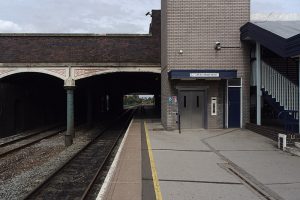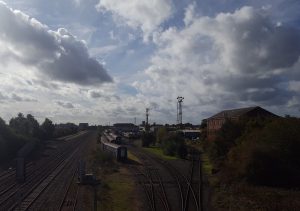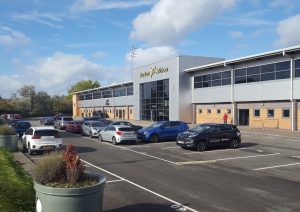Burton Albion 1 Morecambe 1
League 1
Saturday 15 October 2022

beer is best
The context
We needed a game to watch and hadn’t been here for ages. The previous occasion was during Burton’s early days as League members; they played Bristol Rovers, whose fans turned up in significant numbers for their first visit. I remember faggots and peas, meeting some rough diamonds from Hartcliffe and not much else. The home side no doubt included at least two ex-Forest players. Them’s the rules.
The history
Everyone associates Burton with beermaking. Its water has ideal chemical composition for brewing, via a process known as “Burtonisation”; other circumstances contributed, not least the River Trent becoming increasingly navigable after 1712. This made exports possible from Hull to Holland. Expanding canal networks, meanwhile, opened up new markets in London and Lancashire. Over 30 breweries operated here by 1880.
Only Bass and Marstons remain, making Burton’s Marmite plant arguably the beer trade’s most enduring legacy. This opinion-dividing product is a nutritious by-product of brewers’ yeast – extracted using techniques pioneered by German scientist Justus von Liebig – and has been made locally since 1902. Distinctive oval jars feature the French casserole pot after which Marmite (originally sold in similarly-shaped earthenware containers) was named.
Railways aided Burton’s expansion. The Great Northern and Midland companies feuded constantly over lucrative mineral contracts, with their track sharing disputes eventually resulting in an ambitious Y-shaped GNR track extension south of Nottingham. This joined Derbyshire’s coalfield with the main line at Stafford. Burton’s original station expanded significantly, but 1970s reconstruction brought all the blandness you might expect; only at platform level do any original features survive.
Victorian prosperity demanded a successful football team. Burton Swifts just about represented that; founder-members of Division Two, they merged with Burton Wanderers nine years later to form Burton United. This new club survived in the League until 1907, failed to achieve re-election and was replaced by Fulham. Another merger created Burton Town in 1924; their Midland Football League registration would eventually be taken over by newly-formed Burton Albion.
Swifts’ 1890s ground was still used up until twelve months ago. Peel Croft had originally belonged to the local rugby club, who took back possession following United’s demise; I would have liked to visit but it’s a Lidl now. Albion, meanwhile, started off at the Lyons Foundry’s works pitch and then built Eton Park – half a mile distant, opposite Pirelli’s tyre factory – just before their first Southern League season in 1958-59.
(all pictures: Groundtastic)
Eton Park lasted sixty-odd years. Any 1950s fan would still have recognised the old place in 2005, when Albion moved five hundred yards to Pirelli’s disused sports club; a basic grandstand extension clumsily facilitated Conference football, one end gained a new steel roof but nothing else had changed. Low claustrophobic terrace covers, standing on cinders and dreadful views – despite all these, many of us retain surprisingly fond memories of watching football there.
Its biggest game actually took place somewhere else. Neil Warnock’s Northern Premier League side beat six teams – including Fourth Division Aldershot – to reach the 1984-85 FA Cup Third Round, where they drew near-neighbours Leicester City at home. Eton Park was deemed incapable of safely staging this tie so Burton instead borrowed the Baseball Ground. Their well-intentioned but naive decision attracted 22,000 truculent locals, created a vicarious Derby-Leicester needle game and caused predictable chaos.
The atmosphere that damp afternoon was malevolent. With the score 1-1 a missile felled goalkeeper Paul Evans. Doctors wanted Evans to go off, but despite (or perhaps because of) being dazed he continued and conceded five more times. Most of them would probably have gone in anyway; Warnock nevertheless claimed Leicester’s win had been unfairly influenced, the FA agreed and Burton lost a surreal behind closed doors rematch at Coventry witnessed only by empty, snow-covered terraces.
The journey
Westbury Park was our familiar meeting place. As usual we got lost driving across Stoke, somehow winding up a moped rider who chased us for two miles through Longton vigorously giving me the finger. It began to feel like I was playing Dennis Weaver’s role in Duel until he finally turned off somewhere near Gladstone Pottery Museum,
Burton’s ground occupies one of those windswept urban areas that aren’t particularly built up but still manage to offer very limited parking. A nearby industrial estate seemed our best bet, and five quid (requested by one of those high-viz characters who seem legit but are probably just good at taking money off gullible punters) squared the deal. Getting out afterwards proved simplicity itself; we were back on the road by five o’clock, and home in daylight.
The ground
Naming rights should always be supported by history. Plenty else seems forgivable here, despite a singularly basic early-2000s design featuring single seated stand, low-cost perimeter fencing and narrow covered terraces. The Pirelli usually hosts modest crowds – understandable in this Derby County stronghold – but still generates decent noise from partisan fans. Its underpinning corporate and community facilities are no doubt very nice as well.
Flesh and wine
We intended drinking in the same pub as last time but had forgotten which way to go. Luckily the Great Northern – several hundred yards away across some railway lines – proved just right. Plastic glasses suggested things could sometimes get busy; nobody was getting excited today, though, and scattered Burton fans proved pleasant company until kick-off time finally encouraged us all back over the tracks.
I only wanted to eat faggots. Unfortunately – despite the away enclosure food counter advertising them, and stainless steel cooking pots being clearly visible – only anaemic pies were on sale. These admittedly tasted better than they looked; when you’ve glimpsed offal Xanadu, however, anything else is a disappointment. This apart, everyone went out of their way to make several hundred Morecambe supporters feel welcome. Stewards and serving staff exuded warmth while little posters thanked us for travelling.
The game
Burton’s friendliness didn’t stop them closing the visitors’ terrace and making everyone pay full price for seats. Just one point separated this relegation-haunted pair, but the home side looked sharpest; they duly went ahead, Davis Keillor-Dunn finishing calmly after Conor Ripley neglected to cover his far post. Liam Gibson should then have equalised from Cole Stockton’s square ball but Ben Garratt saved superbly.
Today’s bright sunshine had been varied by violent hail just before half time. It seemed to wake Morecambe up and they nearly profited from frantic goalmouth scrambling when Garratt dropped the ball. Their late equaliser came courtesy of defender Ryan Delaney, whose swipe from distance caught everyone wrongfooted. This gave sundry Lancashire youths a perfect excuse to bounce around, agitate the stewards and inadvertently put designer footwear through some feeble-looking advertising boards.
Teams and goals
Burton: Garratt, Brayford, Hughes, Mariappa, Hamer, Taylor, Oshilaja, Smith (Carayol 84), Winnall (Powell 42, Kamwa 84), Keilor-Dunn, Adeboyejo. Unused subs: Butcher, Thorpe, Lakin, Sinisalo.
Morecambe: Ripley, Rawson, Bedeau, Delaney, Love (Cooney 45), Shaw (O’Connor 81), Weir (Watts 67), Connolly (Fane 45), Gibson (Mayor 76), Stockton, Phillips. Unused subs: Smith, McLoughlin.
Goals: Burton: Keilor-Dunn 30. Morecambe: Delaney 77.
Attendance: 2602.


















